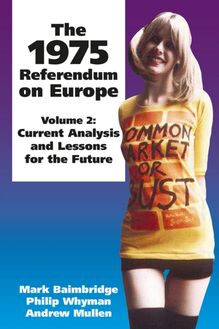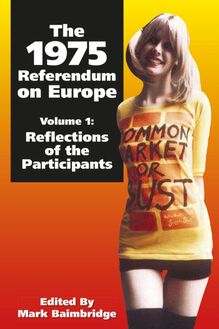1975 Referendum on Europe - Volume 2 , livre ebook
113
pages
English
Ebooks
2016
Vous pourrez modifier la taille du texte de cet ouvrage
Obtenez un accès à la bibliothèque pour le consulter en ligne En savoir plus
Découvre YouScribe en t'inscrivant gratuitement
Découvre YouScribe en t'inscrivant gratuitement
113
pages
English
Ebooks
2016
Vous pourrez modifier la taille du texte de cet ouvrage
Obtenez un accès à la bibliothèque pour le consulter en ligne En savoir plus
Publié par
Date de parution
31 octobre 2016
Nombre de lectures
2
EAN13
9781845406325
Langue
English
Publié par
Date de parution
31 octobre 2016
Nombre de lectures
2
EAN13
9781845406325
Langue
English
THE 1975 REFERENDUM
ON EUROPE
Volume 2
Current Analysis and Lessons for the Future
Mark Baimbridge, Philip Whyman & Andrew Mullen
First published in 2006 by
Imprint Academic, PO Box 200, Exeter EX5 5YX, UK
www.imprint-academic.com
Digital edition converted and distributed by
Andrews UK Limited
www.andrewsuk.com
© Copyright M. Baimbridge, P. Whyman & A. Mullen 2006
The right of M. Baimbridge, P. Whyman & A. Mullen to be identified as the author of this work has been asserted in accordance with the Copyright, Designs and Patents Act 1998.
The moral rights of the authors have been asserted. No part of any contribution may be reproduced in any form without permission, except for the quotation of brief passages in criticism and discussion.
The views and opinions expressed herein belong to the authors and do not necessarily reflect those of Imprint Academic or Andrews UK Limited.
Acknowledgements
There are many people to thank for their input into making this book possible. Firstly, Anthony Freeman of Imprint Academic for his immediate support for this project and patience over the duration of its development. Secondly, this book could not have been completed without the many and varied contributions. Seeking to undertake a project focusing upon an event that occurred some 30 years ago has posed inevitable difficulties as the march of time has severely depleted the number of participants still able to provide their first-hand account of the Referendum. Thirdly, colleagues in the Bradford Centre for International Development, Centre for European Studies at the University of Bradford, the Lancashire Business School at the University of Central Lancashire and the Politics Division at Northumbria University for their support for our research on European integration and the work of the multidisciplinary European Economies Research Unit (EERU) of which this is a prime example of the intersection between political science and economics. Finally, we owe a deep sense of gratitude to our families for their support and forbearance during the preparation of this book. It is to them that this book is dedicated: MB: Mary, Ken and Beibei, PW: Barbara, Boyd and Claire.
Any remaining errors and omissions we gladly attribute to each other.
Haworth, Heaton Norris and Gateshead
June 2006
1. From Membership to Referendum
Introduction
The Referendum of June 1975 was the first, and to-date only, post-legislative referendum to involve the whole of the UK. Theoretically, the issue was relatively simple, namely whether to accept the renegotiated terms of UK membership and remain within the European Economic Community (EEC). However, as with so many political events its apparent simplicity conceals hidden depths that were to plunge the then Labour administration of Harold Wilson and every successive British government into the quagmire that Britain’s relationship with ‘Europe’ would become. This chapter firstly reviews the early development of the European Union (EU) from the initial post-war integrationalist trends which were largely driven by the growing reality of the Cold War to the renewed sense of dynamism generated by the 1969 Hague Summit which led to the first enlargement , thus bringing the EU-UK into focus. Secondly, it summarises Britain’s ‘road to membership’ which was accelerated by various economic and political forces, both internal and external, that combined inexorably to suggest that EEC membership would provide a shield from the growing gales of globalisation and match the geopolitical reality of the UK in the post-war era. This section also includes a brief description of the countdown to the Referendum that was triggered several years before within the Shadow Cabinet of Harold Wilson in the interests of maintaining Party unity. Hence, following Labour’s return to power in 1974 an inevitable series of events were placed into motion that led through a renegotiation process to the Referendum itself in June 1975. Finally, the chapter concludes with an overview of the book’s principal themes.
Although the number of books analysing contemporary European economic integration have multiplied over recent years a number of weaknesses remain. Firstly, many texts seek to maximise their marketability by attempting to cover the entire spectrum of EU related topics, but ultimately only do so at a superficial level. Whilst certain areas may lend themselves to a brief examination presented in a single chapter, many others are too complex to summarise in such a manner and require a more sophisticated approach if all the principal issues are to be analysed. Clearly, even the most cursory discussion of the 1975 Referendum should seek to encompass the considerable underpinnings of this area in terms of its economic and political debate, review its historical background and consider how the Referendum features within the present discussion of Britain’s membership of the EU.
Given the significance of the occurrence in terms of the British constitution , cabinet collective responsibility, party cohesion, let alone the possibility that Britain might leave the EEC a mere 203 days after gaining entry, it is surprising how little has been written on this topic with only Butler and Kitzinger (1976), Goodhart (1976) and King (1977) analysing the event itself in its immediate aftermath. Prior to the unfulfilled expectation of a referendum regarding Britain’s entry into the single currency, a number of studies were made, inter alia , Baimbridge et al . (2000), Dyson (2000), Temperton (2001), El-Agraa (2002), Baimbridge and Whyman (2003). However, a more recent book by O’Hara (2006), The referendum roundabout , seeks to review the role of the referendum in modern British politics through a detailed analysis of the 1975 vote on Europe. Moreover the phenomenon of the referendum itself as a feature within the British political landscape has likewise received relatively scant attention with the works of Butler and Ranney (1980 & 1994), Bogdanor (1981), Gallagher and Uleri (1996), Hug (2002) and Qvortrup (2002) illustrating the fractured discourse on this topic.
Although numerous politicians and Whitehall insiders have frequently covered this topic in biographies, these are inevitably from a single perspective thereby offering a unique, yet ultimately limited analysis. Therefore, given the relative paucity of credible literature on this topic it was decided to divide the analysis of the Referendum across two separate, yet complementary, texts. Hence, the companion text: The 1975 referendum on Europe: reflections of the participants (Baimbridge, 2006) adopts a more informal approach through combining the analysis of selected themes with the personal recollections of figures such as David Owen, Tony Benn, John Edmonds, Tam Dalyell, Teddy Taylor, Richard Body, Ernest Wistrich and Uwe Kitzinger.
A second problem for those seeking a greater understanding of European integration is that many books adopt a far from neutral stance when explaining the relevant arguments. It is, of course, natural that academics, politicians, trade unionists and general commentators who have self-selected European integration as their speciality, are likely to posses strong opinions towards this subject. Indeed, this is the case with the authors of this book. However, we have striven to ensure that this book succeeds in portraying the concept of the 1975 Referendum in a balanced light.
Thirdly, the fast-moving events of European integration can result in books becoming out dated soon after, or even before, their publication ! Indeed, part of our initial strategy regarding this book was not only the advent of the 30 th anniversary of the 1975 Referendum, but that the referendum issue would again become a central contemporary British political theme in relation to possible EMU membership , albeit at an unspecified date, and the European Constitutional Treaty which was pencilled-in for early 2006. However, the latter was derailed by the French and Dutch ‘no’ votes in mid-2005 resulting in a ‘period of reflection’ by the EU. Consequently, the immediate prospect of nationwide referendums on these EU-related questions is now diminished. However, the 1975 Referendum still represents the unique comparator for any future referendums, which have gathered considerable pace across the EU in the past 20 years with the noticeable exception of Britain.
This book seeks to both review aspects of the Referendum and look ahead to the prospect of two further referendums concerning the UK’s relationship with the EU. Firstly, there is the longstanding commitment of the current Labour government to consult the people once the Treasury tests of October 1997 are satisfied regarding UK entry into Economic and Monetary Union (EMU). Although a recent speech by Tony Blair (2006) seems to suggest that ‘the economics had to be got right and the politics follow’, reversing the original position. Secondly, a key EU process has been the process started following the Laeken declaration in December 2001, when the European Convention was established to produce a draft of the Constitution, headed by former French President Valery Giscard d’Estaing. However, the failure of the French and Dutch electorate to support the proposed Treaty establishing a Constitution for Europe in May and June 2005 halted its progress. Whilst neither of these issues are currently at the forefront of political debate, they are nevertheless still on the long-term agenda of the EU and would involve nationwide referendums not previously witnessed since the 1975 Referendum. Hence, a method of resolving significant political and economic issues that had lain dormant at a national level for more than 30 years would potentially be activated twice in

